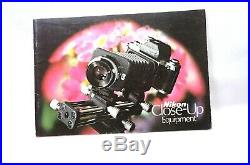
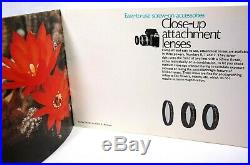
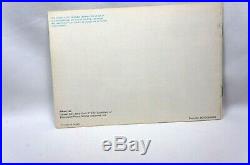
Medical Nikkor Auto PB-5, Bellow Focusing. Used Very Good and Very Clean Condition. I would rate it 8.5 on a scale of 1-10. I try to describe the item as honestly and completely as I can. Photos are of the actual item for sale. Please check photos for actual condition. Thank you for watching my listing and God Bless yo. Please take a look at my other auctions. Comes from a smoke free environment. Please give us a chance to fix a problem before leaving feedback. If you have any problems or questions, please contact me right away. We are not able to do this on legal or ethical grounds. This is the best way to be sure that your item reaches you safely and without any extra delays. Thank you for your understanding. The item “VTG Nikon Close-Up Equipment Brochure Medical Nikkor Auto PB-5 Bellow Focusing” is in sale since Wednesday, August 12, 2020. This item is in the category “Cameras & Photo\Camera Manuals & Guides”. The seller is “vivalasvegas2525″ and is located in Las Vegas, Nevada. This item can be shipped worldwide.
- Country/Region of Manufacture: Japan
- Custom Bundle: No
- Compatible Brand: For Nikon
- Type: Brochure
- Compatible Model: Nikon
- Compatible Series: Nikon
- Compatible Camera Type: Film SLR
- MPN: does not apply
- Item Weight: 6oz
- Brand: Nikon
- Manufacturer Warranty: None
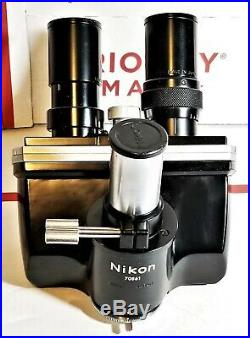
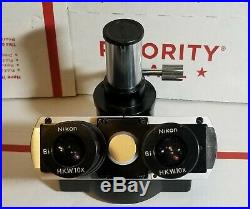
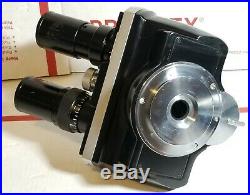
Up for Sale is a vintage Trinocular Head for Nikon Microscopes. It will fit many older instruments such as the S line and other companies that have similar instruments. Its very clean and the optics are clear. I have more microscopes and accessories, books, and slides that I will be listing over the next month. I have an extensive amount of instruments, etc and I love projects. Please Feel Free to MAKE an OFFER! CHECK OUT MY OTHER AUCTIONS–MORE test equipment items are being listed in the next few weeks! THIS ITEM SHIPS ONLY TO US ADDRESSES! MUST BE Payed WITHIN 3 DAYS! The free listing tool. The item “Nikon Trinocular Head with PHOTO Tube for Vintage Nikon Microscopes” is in sale since Thursday, February 28, 2019. This item is in the category “Business & Industrial\Healthcare, Lab & Dental\Medical & Lab Equipment, Devices\Microscopes”. The seller is “electro1chem2″ and is located in Las Vegas, Nevada. This item can be shipped to United States.
- Brand: Nikon
- MPN: Does Not Apply
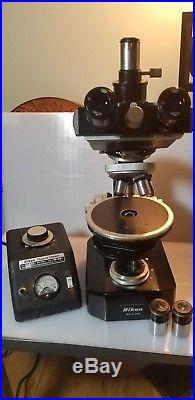
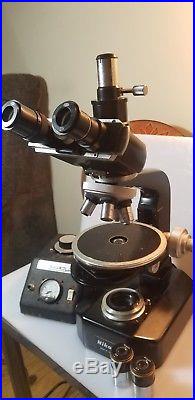
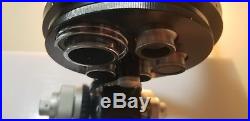
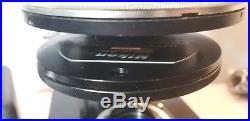
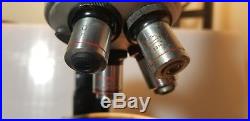
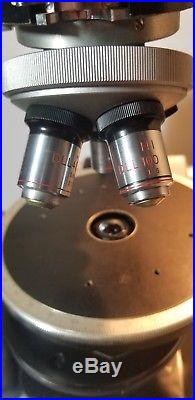
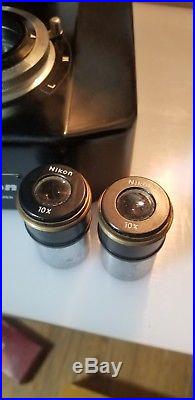
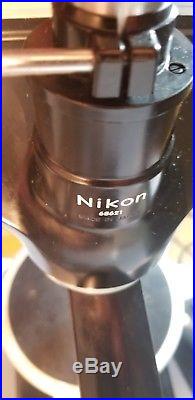
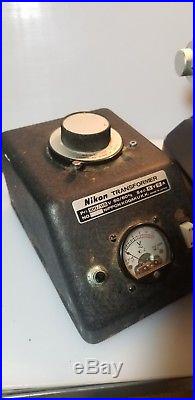
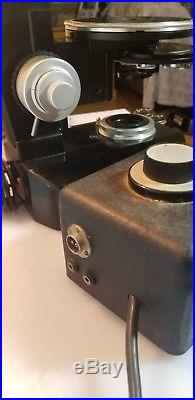
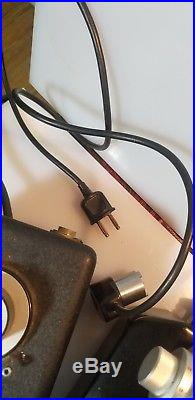
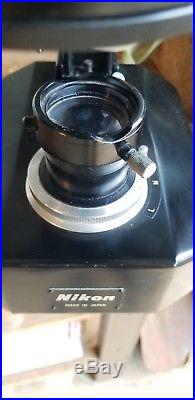
Microscope is in fantastic, working condition. Shows only minor wear from use, comes with an extra set of olympus optics. The bulb blew, so will need a replacement bulb. Transformer unfortunately has some rust, but works well. Also has a nikon interference phase contrast condenser. Plug end of bulb is too narrow to fit the power supply, so assuming the cord is not original to this unit. Units were tested separately of each other. Excellent, rare example of a great microscope. What you see in pictures is what you will receive. The item “Nikon S-ke S L-ke microscope, 1960s vintage scope, extra optics, works great” is in sale since Monday, November 19, 2018. This item is in the category “Business & Industrial\Healthcare, Lab & Dental\Medical & Lab Equipment, Devices\Microscopes”. The seller is “ytmarshall” and is located in Culpeper, Virginia. This item can be shipped to United States, Canada, United Kingdom, Denmark, Romania, Slovakia, Bulgaria, Czech republic, Finland, Hungary, Latvia, Lithuania, Malta, Estonia, Australia, Greece, Portugal, Cyprus, Slovenia, Japan, China, Sweden, South Korea, Indonesia, Taiwan, Thailand, Belgium, France, Hong Kong, Ireland, Netherlands, Poland, Spain, Italy, Germany, Austria, Bahamas, Israel, Mexico, New Zealand, Philippines, Singapore, Switzerland, Norway, Saudi arabia, Ukraine, United arab emirates, Qatar, Kuwait, Bahrain, Croatia, Malaysia, Chile, Colombia, Costa rica, Panama, Trinidad and tobago, Guatemala, Honduras, Jamaica, Antigua and barbuda, Aruba, Belize, Dominica, Grenada, Saint kitts and nevis, Saint lucia, Montserrat, Turks and caicos islands, Barbados, Bangladesh, Bermuda, Brunei darussalam, Bolivia, Egypt, French guiana, Guernsey, Gibraltar, Guadeloupe, Iceland, Jersey, Jordan, Cambodia, Cayman islands, Liechtenstein, Sri lanka, Luxembourg, Monaco, Macao, Martinique, Maldives, Nicaragua, Oman, Pakistan, Paraguay, Reunion.
- Brand: Nikon
- Model: S-ke
- Optical/Digital: Optical
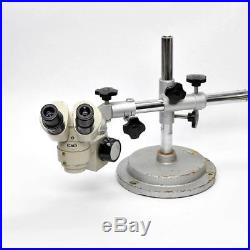
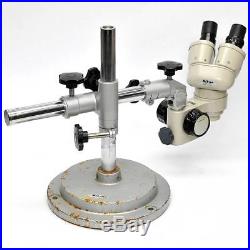
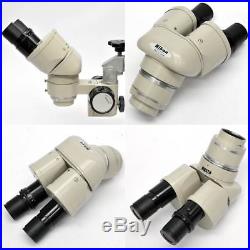
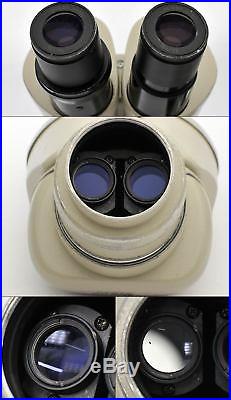
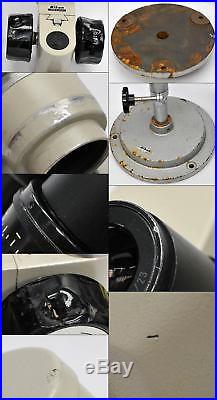
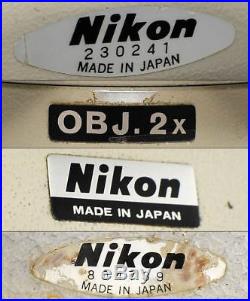
Nikon SM-5 Stereo Microscope With Universal Table Stand 20x Vintage Stereoscopic. Comes in non-original packaging. This lot is in Good cosmetic condition considering the scope is possibly 50+ years old. The ugliest part is the focusing knobs, which are somehow melted-looking, we are not sure why. There is a ding on one corner of a prism box (the prisms were not damaged) and a small chip on one objective lens (this surprisingly does not affect images seen in the scope). The base of the stand is quite rusty, especially on the bottom. There are minor scuffs/scratches here and there as well as residues from prior use. The optics were recently cleaned. This microscope is in Good working condition. The view through the scope is upright, clear and aligned. The optics are bright enough that an external illuminator is not necessary when the ambient light is moderately-bright. The adjustments on the stand work as expected and lock firmly in position. The focus mount is the only half-not-great part: the tension adjustment will sometimes loosen itself if you turn in a “down” direction with the right (adjustment) focus knob. No other testing was done. No manuals, cords/cables, or additional items are included if not listed or shown. (1) Nikon SM-5 Stereoscopic Microscope. (1) C-FMA Focusing Mount. (1) Universal Table Stand. Fixed magnification (no zoom). Magnification as equipped: 20x. True Greenough type dual lightpath optics. Can accept auxiliary objectives or different eyepieces for different magnification levels (not included). Eyepieces: 10x/23, high eyepoint suitable for use with glasses. Focus travel, approximate: 1.62. Boom arm and focus mount can be locked in position to hold scope at almost any angle. Focus mount pin to stand upright, approximate: 4″ to 11″. Bottom of stand to bottom of microscope height, approximate: -0.5″ to +14″. Heavy 9.5 diameter base holds stand firmly, also has bolt-down holes for absolute security. For questions regarding this item, please reference the SKU to help us better serve you. DougDeals Terms and Conditions. DougDeals Terms of Use. DougDeals directly accepts US and Canadian issued credit cards only. This item is guaranteed to be as described. See full terms here. DougDeals reserves the right to refuse service to anyone that does not comply with the terms listed and linked here. The sole and exclusive venue for any lawsuit arising out of or relating to this agreement shall be the Travis County Civil Courts of Travis County, Texas. The item “Nikon SM-5 Stereo Microscope With Universal Table Stand 20x Vintage Stereoscopic” is in sale since Wednesday, June 27, 2018. This item is in the category “Business & Industrial\Healthcare, Lab & Dental\Medical & Lab Equipment, Devices\Microscopes”. The seller is “athomemarket” and is located in Leander, Texas. This item can be shipped worldwide.
- Brand: Nikon
- MPN: SM-5
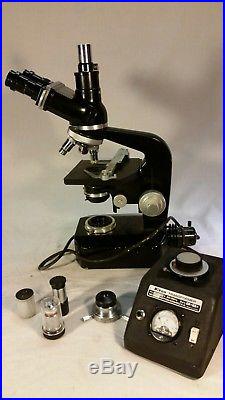
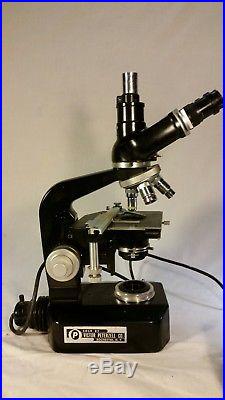
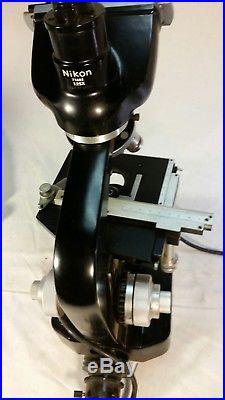
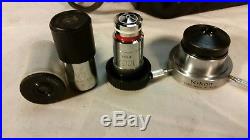
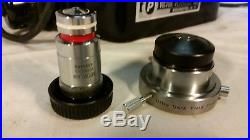
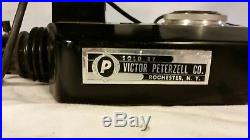
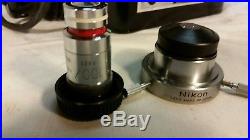
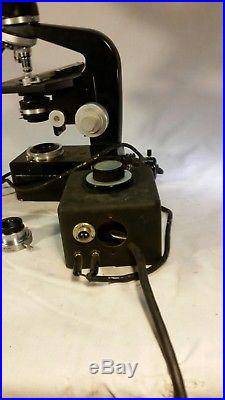
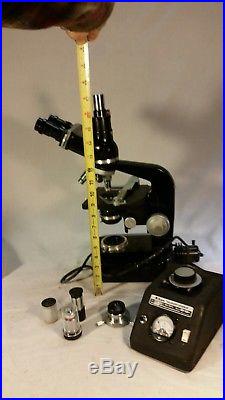
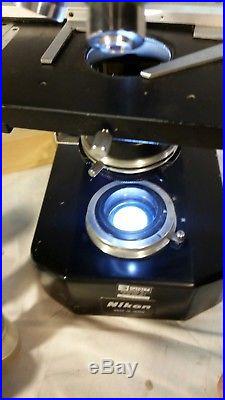
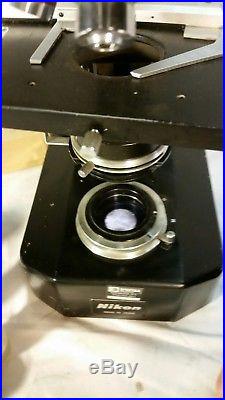
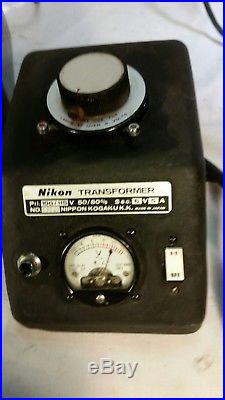
Rare Nikon s-ke microscope in great working condition with Kohler illuminator, transformer and extra optics. Nikon 71482 1.25x labeled on upper back. Everything works great and is in excellent condition. Sale includes everything in pictures. I tested the microscope to the best of my ability and found it easy to use and that all dials and adjustments moved smoothly. The only thing i found with this Nikon S-ke set up that didn’t work as expected is the indicator light on the transformer. The transformer does work well and the dial on it moved as i adjusted the light. Please ask for any additional tests, pictures or additional information. I try and display and describe everything i sell honestly and correctly, taking care to note any and all imperfections. I hope this microscope find a new home that can utilize it’s potential and appreciate it’s form and function. Model S-Ke Microscope (Circa late 1960s) The S-Ke was the first Nikon microscope equipped with a Köhler illuminator built into the microscope base, enabling convenient and perfect photomicrography when a camera was mounted and used with one of Nikon’s Microflex adapters. A reflecting mirror was provided as an accessory and could replace the illumination field lens to provide light from a source outside the microscope. Like the basic Model S, interchangeable parts made the Model S-Ke microscope a versatile tool for studies in biology, medicine, and metallurgy. Depending on the user’s needs, it could be equipped with various combinations of eyepieces, eyepiece tubes, objectives, condensers, and stages. This microscope, built during the 1960s and 1970s, was provided with a coaxial set of coarse and fine focusing knobs, which were located near the base. A preset device allowed quick refocusing after the stage was lowered for changing a specimen or applying immersion oil. A wooden cabinet was also available for storage when the microscope was not in use. There were five selections of eyepiece tubes available: inclined monocular, inclined monocular with an inclined phototube, binocular, and two versions of trinocular. Four interchangeable stages provided a choice of surfaces for examining specimens: a rectangular mechanical stage, circular floating, graduated, circular rotatable, and a plain square stage. A variety of achromatic and apochromatic objectives were available, designed specifically for either metallurgical (episcopic) or biological/medical (diascopic) uses. Reviews on the Nikon s-ke From the point of view of design and functionality, it may be the pinnacle of the light microscope. It combines superb optics, smoothness of movement, a steady platform, and a beautiful streamlined design reminiscent of aerodynamic designs of the 1940′s. Since the era of the SKe, microscopes have become lighter and larger, more complex and complete, but not necessarily better. This particular model has a built in light and separate transformer that are capable of koehler illumination. It has concentric coarse and fine focus knobs with a stop lever to prevent the lens from lowering into the slide. The two binocular 10x eyepieces are also Nikon. According to Nikon; this Ke base houses a complete Koehler illuminating and optical system, making the most efficient use of available light, as only the area under inspection is illuminated. Glare, flare and halo effects are reduced to a minimum. A built-in base turret with auxiliary condenser lenses to adjust the illumination for low, medium and high power objectives is one of the features that makes it an ideal microscope for both visual and photomicrographic applications. About the ultra dark field condenser Darkfield contrast technique where only light diffracted from the specimen is used to form the image TECHNOLOGY: Darkfield microscopy creates contrast in transparent unstained specimens such as living cells. It depends on controlling specimen illumination so that central light which normally passes through and around the specimen is blocked. Rather than light illuminating the sample with a full cone of light (as in brightfield microscopy) the condenser forms a hollow cone with light travelling around the cone rather than through it. This form of illumination allows only oblique rays of light to strike the specimen on the microscope stage and the image is formed by rays of light scattered by the sample and captured in the objective lens. When there is no sample on the microscope stage the view is completely dark. Care should be taken in preparing specimens as features above and below the plane of focus can also scatter light and compromise image quality (for example, dust, fingerprints). In general, thin specimens are better because the possibility of diffraction artifacts is reduced. APPLICATIONS: In darkfield microscopy, contrast is created by a bright specimen on a dark background. It is ideal for revealing outlines, edges, boundaries, and refractive index gradients but does not provide a great deal of information about internal structure. Ideal subjects include living, unstained cells (where darkfield illumination provides information not visible with other techniques), although fixed stains cells can also be imaged successfully. Darkfield imaging is particularly useful in haematology for the examination of fresh blood. Non-biological specimens include minerals, chemical crystals, colloidal particles, inclusions and porosity in glass, ceramics, and polymer thin sections…. Objectives designed to be used with reflected darkfield illumination have a special construction consisting of a 360-degree hollow chamber surrounding the centrally located lens elements. Light from the illuminator passes through the periphery of the objective and is directed at the specimen from every azimuth in oblique rays to form a hollow cone of illumination. This is often accomplished by means of circular mirrors or prisms located at the bottom of the objective’s hollow chamber. In this manner, the objective serves as two separate optical systems coupled coaxially such that the outer system functions as a “condenser” and the inner system as a typical objective. The item “Nikon S-ke microscope, rare 1960s vintage scope, extra optics, works great” is in sale since Wednesday, July 25, 2018. This item is in the category “Business & Industrial\Healthcare, Lab & Life Science\Lab Equipment\Microscopes”. The seller is “konga33″ and is located in New Tazewell, Tennessee. This item can be shipped worldwide.
- Brand: Nikon
- Model: S-ke
- Optical/Digital: Optical
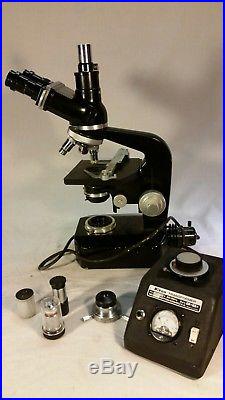
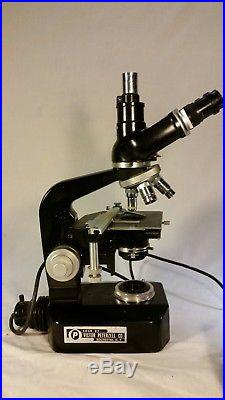
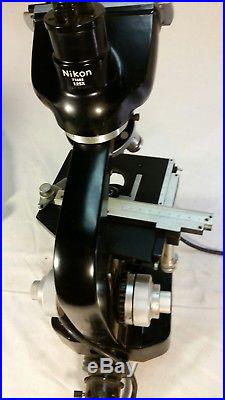
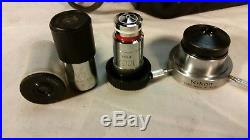
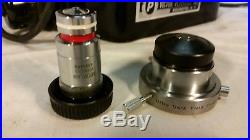
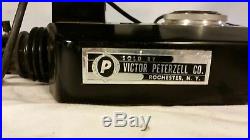
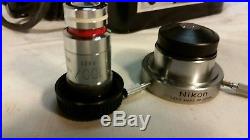
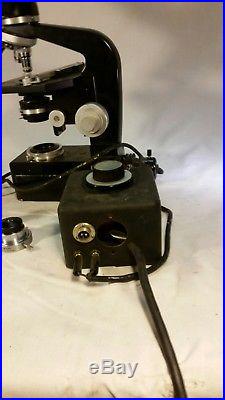
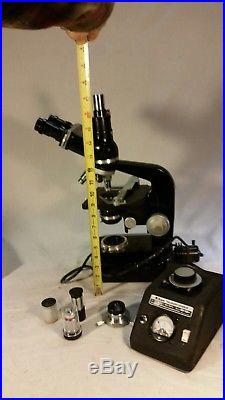
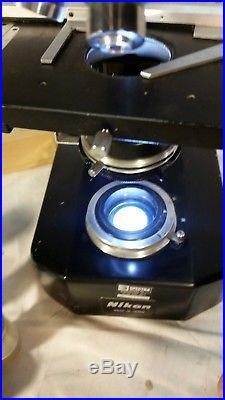
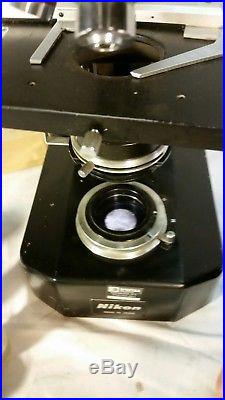
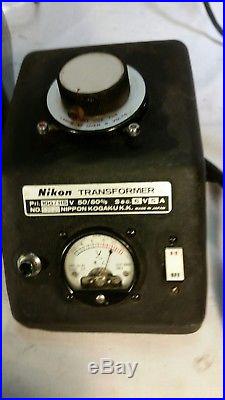
Rare Nikon s-ke microscope in great working condition with Kohler illuminator, transformer and extra optics. Nikon 71482 1.25x labeled on upper back. Everything works great and is in excellent condition. Sale includes everything in pictures. I tested the microscope to the best of my ability and found it easy to use and that all dials and adjustments moved smoothly. The only thing i found with this Nikon S-ke set up that didn’t work as expected is the indicator light on the transformer. The transformer does work well and the dial on it moved as i adjusted the light. Please ask for any additional tests, pictures or additional information. I try and display and describe everything i sell honestly and correctly, taking care to note any and all imperfections. I hope this microscope find a new home that can utilize it’s potential and appreciate it’s form and function. Model S-Ke Microscope (Circa late 1960s) The S-Ke was the first Nikon microscope equipped with a Köhler illuminator built into the microscope base, enabling convenient and perfect photomicrography when a camera was mounted and used with one of Nikon’s Microflex adapters. A reflecting mirror was provided as an accessory and could replace the illumination field lens to provide light from a source outside the microscope. Like the basic Model S, interchangeable parts made the Model S-Ke microscope a versatile tool for studies in biology, medicine, and metallurgy. Depending on the user’s needs, it could be equipped with various combinations of eyepieces, eyepiece tubes, objectives, condensers, and stages. This microscope, built during the 1960s and 1970s, was provided with a coaxial set of coarse and fine focusing knobs, which were located near the base. A preset device allowed quick refocusing after the stage was lowered for changing a specimen or applying immersion oil. A wooden cabinet was also available for storage when the microscope was not in use. There were five selections of eyepiece tubes available: inclined monocular, inclined monocular with an inclined phototube, binocular, and two versions of trinocular. Four interchangeable stages provided a choice of surfaces for examining specimens: a rectangular mechanical stage, circular floating, graduated, circular rotatable, and a plain square stage. A variety of achromatic and apochromatic objectives were available, designed specifically for either metallurgical (episcopic) or biological/medical (diascopic) uses. Reviews on the Nikon s-ke From the point of view of design and functionality, it may be the pinnacle of the light microscope. It combines superb optics, smoothness of movement, a steady platform, and a beautiful streamlined design reminiscent of aerodynamic designs of the 1940′s. Since the era of the SKe, microscopes have become lighter and larger, more complex and complete, but not necessarily better. This particular model has a built in light and separate transformer that are capable of koehler illumination. It has concentric coarse and fine focus knobs with a stop lever to prevent the lens from lowering into the slide. The two binocular 10x eyepieces are also Nikon. According to Nikon; this Ke base houses a complete Koehler illuminating and optical system, making the most efficient use of available light, as only the area under inspection is illuminated. Glare, flare and halo effects are reduced to a minimum. A built-in base turret with auxiliary condenser lenses to adjust the illumination for low, medium and high power objectives is one of the features that makes it an ideal microscope for both visual and photomicrographic applications. About the ultra dark field condenser Darkfield contrast technique where only light diffracted from the specimen is used to form the image TECHNOLOGY: Darkfield microscopy creates contrast in transparent unstained specimens such as living cells. It depends on controlling specimen illumination so that central light which normally passes through and around the specimen is blocked. Rather than light illuminating the sample with a full cone of light (as in brightfield microscopy) the condenser forms a hollow cone with light travelling around the cone rather than through it. This form of illumination allows only oblique rays of light to strike the specimen on the microscope stage and the image is formed by rays of light scattered by the sample and captured in the objective lens. When there is no sample on the microscope stage the view is completely dark. Care should be taken in preparing specimens as features above and below the plane of focus can also scatter light and compromise image quality (for example, dust, fingerprints). In general, thin specimens are better because the possibility of diffraction artifacts is reduced. APPLICATIONS: In darkfield microscopy, contrast is created by a bright specimen on a dark background. It is ideal for revealing outlines, edges, boundaries, and refractive index gradients but does not provide a great deal of information about internal structure. Ideal subjects include living, unstained cells (where darkfield illumination provides information not visible with other techniques), although fixed stains cells can also be imaged successfully. Darkfield imaging is particularly useful in haematology for the examination of fresh blood. Non-biological specimens include minerals, chemical crystals, colloidal particles, inclusions and porosity in glass, ceramics, and polymer thin sections…. Objectives designed to be used with reflected darkfield illumination have a special construction consisting of a 360-degree hollow chamber surrounding the centrally located lens elements. Light from the illuminator passes through the periphery of the objective and is directed at the specimen from every azimuth in oblique rays to form a hollow cone of illumination. This is often accomplished by means of circular mirrors or prisms located at the bottom of the objective’s hollow chamber. In this manner, the objective serves as two separate optical systems coupled coaxially such that the outer system functions as a “condenser” and the inner system as a typical objective. The item “Nikon S-ke microscope, rare 1960s vintage scope, extra optics, works great” is in sale since Saturday, June 23, 2018. This item is in the category “Business & Industrial\Healthcare, Lab & Life Science\Lab Equipment\Microscopes”. The seller is “konga33″ and is located in New Tazewell, Tennessee. This item can be shipped worldwide.
- Model: S-ke
- Brand: Nikon
- Optical/Digital: Optical
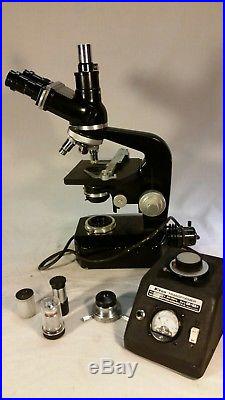
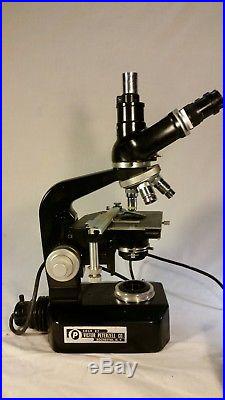
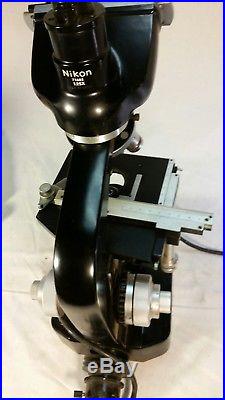
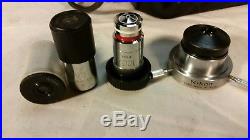
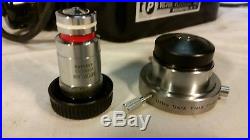
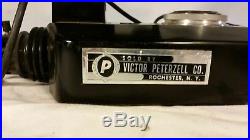
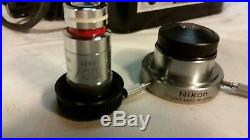
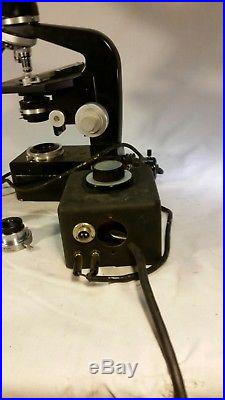
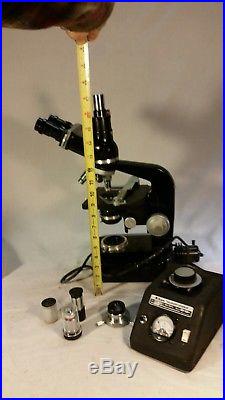
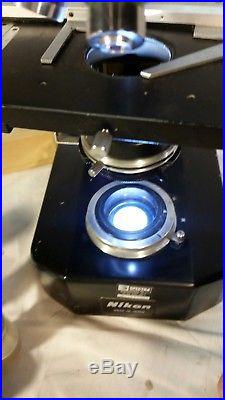
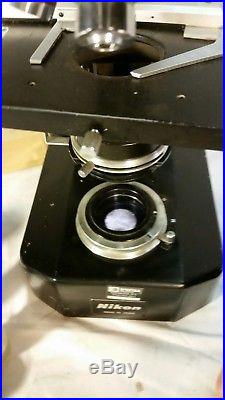
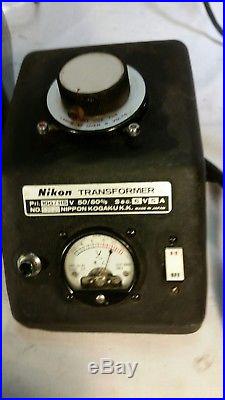
Rare Nikon s-ke microscope in great working condition with Kohler illuminator, transformer and extra optics. Nikon 71482 1.25x labeled on upper back. Everything works great and is in excellent condition. Sale includes everything in pictures. I tested the microscope to the best of my ability and found it easy to use and that all dials and adjustments moved smoothly. The only thing i found with this Nikon S-ke set up that didn’t work as expected is the indicator light on the transformer. The transformer does work well and the dial on it moved as i adjusted the light. Please ask for any additional tests, pictures or additional information. I try and display and describe everything i sell honestly and correctly, taking care to note any and all imperfections. I hope this microscope find a new home that can utilize it’s potential and appreciate it’s form and function. Model S-Ke Microscope (Circa late 1960s) The S-Ke was the first Nikon microscope equipped with a Köhler illuminator built into the microscope base, enabling convenient and perfect photomicrography when a camera was mounted and used with one of Nikon’s Microflex adapters. A reflecting mirror was provided as an accessory and could replace the illumination field lens to provide light from a source outside the microscope. Like the basic Model S, interchangeable parts made the Model S-Ke microscope a versatile tool for studies in biology, medicine, and metallurgy. Depending on the user’s needs, it could be equipped with various combinations of eyepieces, eyepiece tubes, objectives, condensers, and stages. This microscope, built during the 1960s and 1970s, was provided with a coaxial set of coarse and fine focusing knobs, which were located near the base. A preset device allowed quick refocusing after the stage was lowered for changing a specimen or applying immersion oil. A wooden cabinet was also available for storage when the microscope was not in use. There were five selections of eyepiece tubes available: inclined monocular, inclined monocular with an inclined phototube, binocular, and two versions of trinocular. Four interchangeable stages provided a choice of surfaces for examining specimens: a rectangular mechanical stage, circular floating, graduated, circular rotatable, and a plain square stage. A variety of achromatic and apochromatic objectives were available, designed specifically for either metallurgical (episcopic) or biological/medical (diascopic) uses. Reviews on the Nikon s-ke From the point of view of design and functionality, it may be the pinnacle of the light microscope. It combines superb optics, smoothness of movement, a steady platform, and a beautiful streamlined design reminiscent of aerodynamic designs of the 1940′s. Since the era of the SKe, microscopes have become lighter and larger, more complex and complete, but not necessarily better. This particular model has a built in light and separate transformer that are capable of koehler illumination. It has concentric coarse and fine focus knobs with a stop lever to prevent the lens from lowering into the slide. The two binocular 10x eyepieces are also Nikon. According to Nikon; this Ke base houses a complete Koehler illuminating and optical system, making the most efficient use of available light, as only the area under inspection is illuminated. Glare, flare and halo effects are reduced to a minimum. A built-in base turret with auxiliary condenser lenses to adjust the illumination for low, medium and high power objectives is one of the features that makes it an ideal microscope for both visual and photomicrographic applications. About the ultra dark field condenser Darkfield contrast technique where only light diffracted from the specimen is used to form the image TECHNOLOGY: Darkfield microscopy creates contrast in transparent unstained specimens such as living cells. It depends on controlling specimen illumination so that central light which normally passes through and around the specimen is blocked. Rather than light illuminating the sample with a full cone of light (as in brightfield microscopy) the condenser forms a hollow cone with light travelling around the cone rather than through it. This form of illumination allows only oblique rays of light to strike the specimen on the microscope stage and the image is formed by rays of light scattered by the sample and captured in the objective lens. When there is no sample on the microscope stage the view is completely dark. Care should be taken in preparing specimens as features above and below the plane of focus can also scatter light and compromise image quality (for example, dust, fingerprints). In general, thin specimens are better because the possibility of diffraction artifacts is reduced. APPLICATIONS: In darkfield microscopy, contrast is created by a bright specimen on a dark background. It is ideal for revealing outlines, edges, boundaries, and refractive index gradients but does not provide a great deal of information about internal structure. Ideal subjects include living, unstained cells (where darkfield illumination provides information not visible with other techniques), although fixed stains cells can also be imaged successfully. Darkfield imaging is particularly useful in haematology for the examination of fresh blood. Non-biological specimens include minerals, chemical crystals, colloidal particles, inclusions and porosity in glass, ceramics, and polymer thin sections…. Objectives designed to be used with reflected darkfield illumination have a special construction consisting of a 360-degree hollow chamber surrounding the centrally located lens elements. Light from the illuminator passes through the periphery of the objective and is directed at the specimen from every azimuth in oblique rays to form a hollow cone of illumination. This is often accomplished by means of circular mirrors or prisms located at the bottom of the objective’s hollow chamber. In this manner, the objective serves as two separate optical systems coupled coaxially such that the outer system functions as a “condenser” and the inner system as a typical objective. The item “Nikon S-ke microscope, rare 1960s vintage scope, extra optics, works great” is in sale since Thursday, May 24, 2018. This item is in the category “Business & Industrial\Healthcare, Lab & Life Science\Lab Equipment\Microscopes”. The seller is “konga33″ and is located in New Tazewell, Tennessee. This item can be shipped worldwide.
- Optical/Digital: Optical
- Brand: Nikon
- Model: S-ke
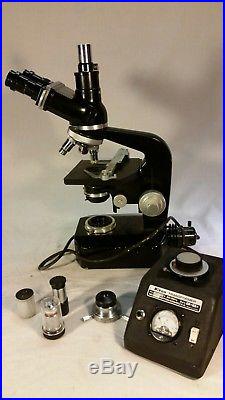
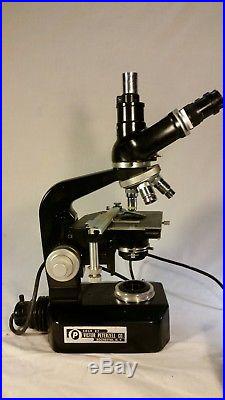
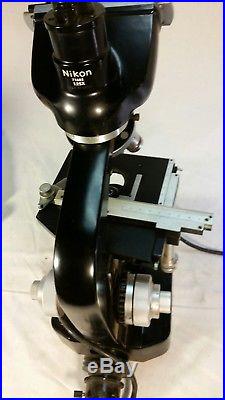
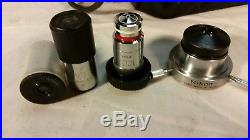
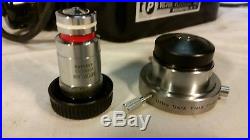
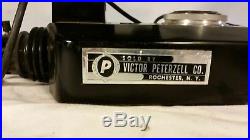
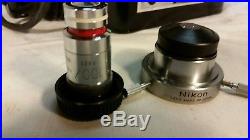
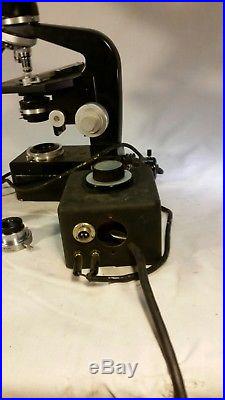
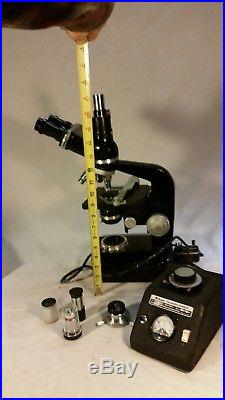
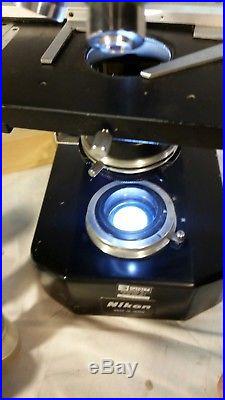
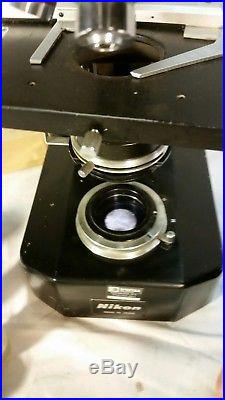
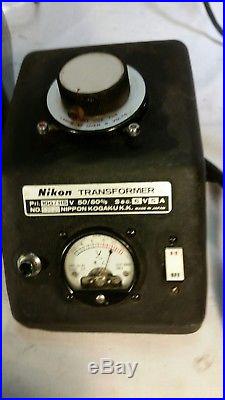
Rare Nikon s-ke microscope in great working condition with Kohler illuminator, transformer and extra optics. Nikon 71482 1.25x labeled on upper back. Everything works great and is in excellent condition. Sale includes everything in pictures. I tested the microscope to the best of my ability and found it easy to use and that all dials and adjustments moved smoothly. The only thing i found with this Nikon S-ke set up that didn’t work as expected is the indicator light on the transformer. The transformer does work well and the dial on it moved as i adjusted the light. Please ask for any additional tests, pictures or additional information. I try and display and describe everything i sell honestly and correctly, taking care to note any and all imperfections. I hope this microscope find a new home that can utilize it’s potential and appreciate it’s form and function. Model S-Ke Microscope (Circa late 1960s) The S-Ke was the first Nikon microscope equipped with a Köhler illuminator built into the microscope base, enabling convenient and perfect photomicrography when a camera was mounted and used with one of Nikon’s Microflex adapters. A reflecting mirror was provided as an accessory and could replace the illumination field lens to provide light from a source outside the microscope. Like the basic Model S, interchangeable parts made the Model S-Ke microscope a versatile tool for studies in biology, medicine, and metallurgy. Depending on the user’s needs, it could be equipped with various combinations of eyepieces, eyepiece tubes, objectives, condensers, and stages. This microscope, built during the 1960s and 1970s, was provided with a coaxial set of coarse and fine focusing knobs, which were located near the base. A preset device allowed quick refocusing after the stage was lowered for changing a specimen or applying immersion oil. A wooden cabinet was also available for storage when the microscope was not in use. There were five selections of eyepiece tubes available: inclined monocular, inclined monocular with an inclined phototube, binocular, and two versions of trinocular. Four interchangeable stages provided a choice of surfaces for examining specimens: a rectangular mechanical stage, circular floating, graduated, circular rotatable, and a plain square stage. A variety of achromatic and apochromatic objectives were available, designed specifically for either metallurgical (episcopic) or biological/medical (diascopic) uses. Reviews on the Nikon s-ke From the point of view of design and functionality, it may be the pinnacle of the light microscope. It combines superb optics, smoothness of movement, a steady platform, and a beautiful streamlined design reminiscent of aerodynamic designs of the 1940′s. Since the era of the SKe, microscopes have become lighter and larger, more complex and complete, but not necessarily better. This particular model has a built in light and separate transformer that are capable of koehler illumination. It has concentric coarse and fine focus knobs with a stop lever to prevent the lens from lowering into the slide. The two binocular 10x eyepieces are also Nikon. According to Nikon; this Ke base houses a complete Koehler illuminating and optical system, making the most efficient use of available light, as only the area under inspection is illuminated. Glare, flare and halo effects are reduced to a minimum. A built-in base turret with auxiliary condenser lenses to adjust the illumination for low, medium and high power objectives is one of the features that makes it an ideal microscope for both visual and photomicrographic applications. About the ultra dark field condenser Darkfield contrast technique where only light diffracted from the specimen is used to form the image TECHNOLOGY: Darkfield microscopy creates contrast in transparent unstained specimens such as living cells. It depends on controlling specimen illumination so that central light which normally passes through and around the specimen is blocked. Rather than light illuminating the sample with a full cone of light (as in brightfield microscopy) the condenser forms a hollow cone with light travelling around the cone rather than through it. This form of illumination allows only oblique rays of light to strike the specimen on the microscope stage and the image is formed by rays of light scattered by the sample and captured in the objective lens. When there is no sample on the microscope stage the view is completely dark. Care should be taken in preparing specimens as features above and below the plane of focus can also scatter light and compromise image quality (for example, dust, fingerprints). In general, thin specimens are better because the possibility of diffraction artifacts is reduced. APPLICATIONS: In darkfield microscopy, contrast is created by a bright specimen on a dark background. It is ideal for revealing outlines, edges, boundaries, and refractive index gradients but does not provide a great deal of information about internal structure. Ideal subjects include living, unstained cells (where darkfield illumination provides information not visible with other techniques), although fixed stains cells can also be imaged successfully. Darkfield imaging is particularly useful in haematology for the examination of fresh blood. Non-biological specimens include minerals, chemical crystals, colloidal particles, inclusions and porosity in glass, ceramics, and polymer thin sections…. Objectives designed to be used with reflected darkfield illumination have a special construction consisting of a 360-degree hollow chamber surrounding the centrally located lens elements. Light from the illuminator passes through the periphery of the objective and is directed at the specimen from every azimuth in oblique rays to form a hollow cone of illumination. This is often accomplished by means of circular mirrors or prisms located at the bottom of the objective’s hollow chamber. In this manner, the objective serves as two separate optical systems coupled coaxially such that the outer system functions as a “condenser” and the inner system as a typical objective. The item “Nikon S-ke microscope, rare 1960s vintage scope, extra optics, works great” is in sale since Monday, April 23, 2018. This item is in the category “Business & Industrial\Healthcare, Lab & Life Science\Lab Equipment\Microscopes”. The seller is “konga33″ and is located in New Tazewell, Tennessee. This item can be shipped worldwide.
- Brand: Nikon
- Model: S-ke
- Optical/Digital: Optical
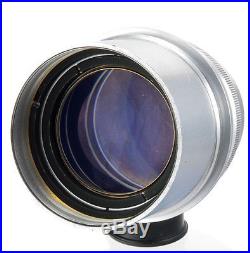
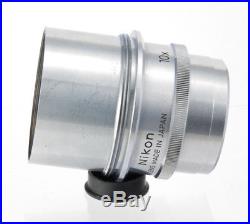
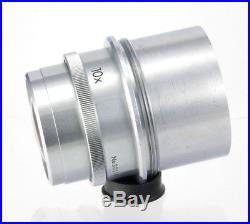
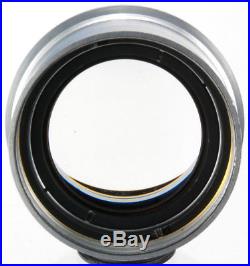
>>> Be sure to add me to your Favorite Stores. Lens for Nikon Profile Projector. The lens is in GOOD condition (see actual pictures). The lens is free of scratches, fungus or dust inside. The lens has cleaning marks. The item pictured is the actual item, you receive what you see on photos. I accept payments in USD, EUROS and GBP. I have a representative in U. Thank you for looking and Good Luck!! The item “NIKON 10x Profile Projector Optical Comparator Lens from Vtg Old Shadowgraph” is in sale since Tuesday, November 01, 2016. This item is in the category “Business & Industrial\Healthcare, Lab & Life Science\Lab Equipment\Microscope Parts & Accessories”. The seller is “suvorov_v” and is located in Europe. This item can be shipped worldwide.
- Brand: Nikon
- Model: Nikon 10x Lens
- MPN: Does Not Apply
- Country/Region of Manufacture: Japan
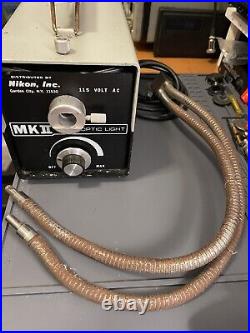
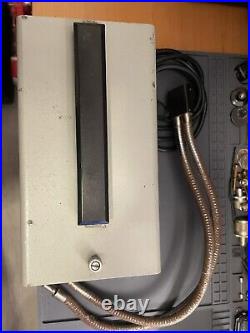
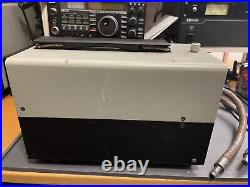
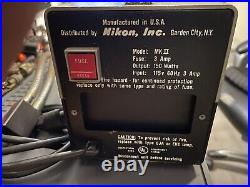
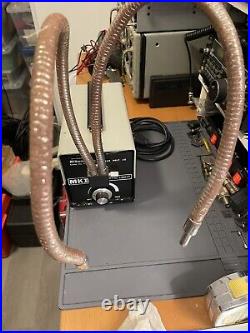
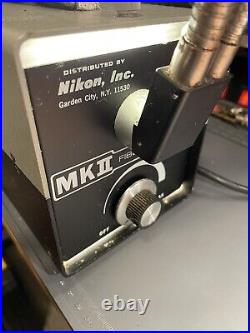
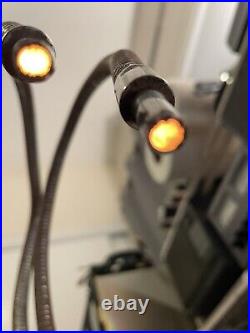
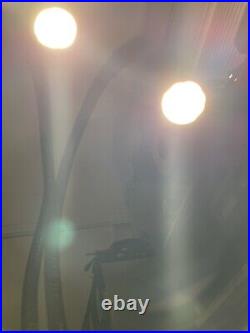
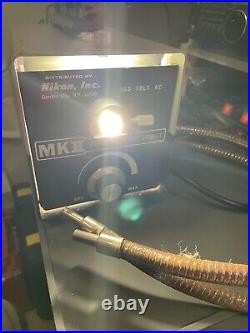
 Posted in
Posted in 

